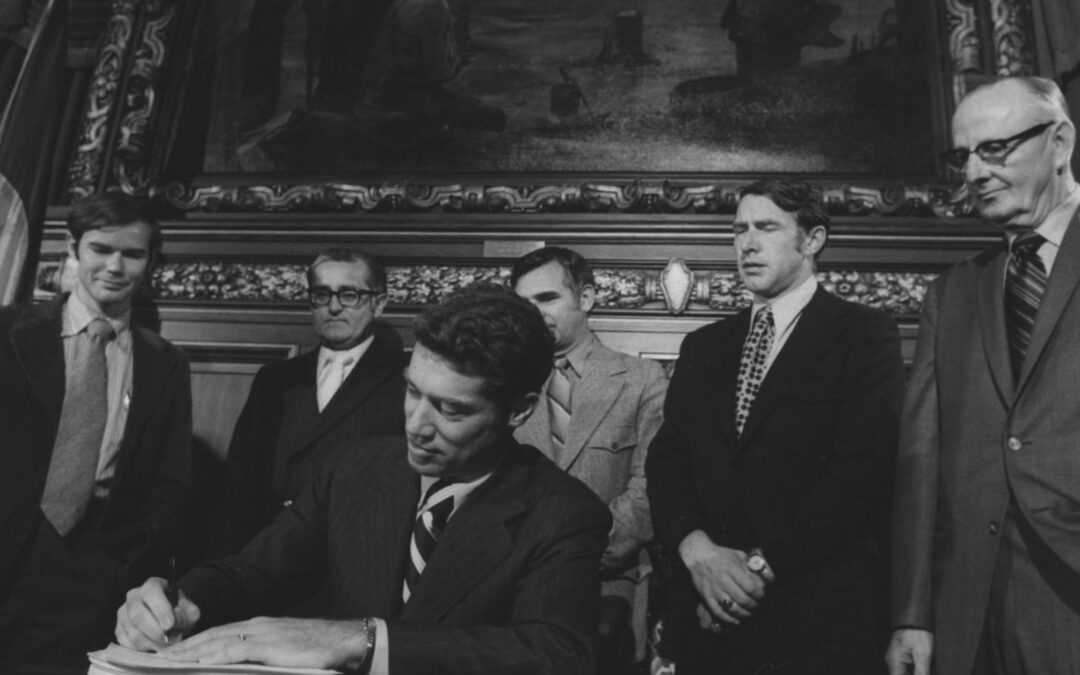Back in November, I told the story of former Minnesota Governor Wendell Anderson:
Elected in 1970, the 37-year-old former Gopher and Olympic hockey player from St. Paul’s East Side faced a Legislature controlled by “conservatives” (legislators were elected on a nonpartisan ballot until 1974). To sell his plan to dramatically increase state personal and corporate income, liquor and cigarette, and the sales tax by $588 million to fund K-12 schools to reduce their dependence on locally levied property taxes and narrow funding disparities, he barnstormed the state and fought through a 157-day special session, the longest in state history. He succeeded in 1971 in what was dubbed the “Minnesota Miracle.”
The essence of the “Minnesota Miracle” was a trade of higher state income taxes for lower local property taxes.
This was a time when increasing rates of inflation were pushing up people’s property values and property tax payments faster than their incomes. At a public meeting at the St. Paul Armory in April 1971, 74 year old Roman Filipczak spoke for many when he said that the annual tax on his St. Paul home had gone up from $200 to $370 in one year, and that he couldn’t afford to pay the increase on his fixed income. “I paid taxes for 50 years,” he said. “Now you want to confiscate my home. For God’s sake, let me die in my home.”
It was also hoped that shifting the burden of education funding from local property to state income taxes would be more “equitable.” In September 1970, the Citizens League issued a report titled “New Formulas for Revenue Sharing In Minnesota,” which outlined the inequalities in education funding that arose when the higher revenues in areas with higher property values were compared with the lower revenues in areas with lower property values. “The locally-collected property tax for schools should be replaced by state-collected taxes,” it concluded. It is hard to think of a more impactful policy paper in our state’s history.
This trade off has held, more or less, for more more than five decades. As Figure 1 shows, the Tax Foundation calculates that, in 2022, the effective rate of property tax paid as a percentage of owner-occupied housing value in Minnesota was 0.98%, ranking us 19th highest in the United States, an unusually low ranking for a Minnesota tax.
Figure 1
At the same time, as Figure 2 shows, the Tax Foundation finds that Minnesota has one of the highest top rates of state income tax in the United States. Minnesota’s top rate of state income tax, 9.85%, is higher than in all but five other states and the income level at which it kicks in, $330,410 for a married couple filing jointly, would be taxed at a lower rate in each of those states except Oregon.
Figure 2
The result, as I have written before, is that Minnesota is one of the most fiscally centralized states in America. As Figure 3 shows, according to Census Bureau data, in 2022 67.1% of Minnesota’s state and local “General revenue from own sources” came from state government sources, the 9th highest share in the United States.
Figure 3: Share of “General government revenue from own sources”

Source: Census Bureau
This trade might now be under threat. Owing to a vast increase in state government spending in the 2023 session, Minnesota’s state government is now looking at a forecast budget deficit of $3.5 billion in the 2028-2029 biennium, or $5.1 billion if you account for inflation. Closing this deficit, as the state government is constitutionally required to do, will require some painful measures.
The Minnesota Reformer reports:
Gov. Tim Walz’s proposed health and human services budget would cut spending by about $1.3 billion over four years and would shift some costs to Minnesota’s counties, causing property taxes to rise, some rural county officials said during a Capitol press conference Wednesday.
…
Walz last month proposed slowing increases on disability services, one of the major drivers of the state’s escalating costs. Appearing with Senate Republicans, the county officials said the burden would fall to counties — and their taxpayers.
“Carlton County … calls on the governor to consider an alternative budget that does not shift the tax burden from the state to local governments, creating a disparate impact on more rural counties, especially,” said Carlton County Administrator Dennis Genereau.
…
Of particular concern for counties is Walz’s proposal to establish a 5% county share for residential services paid through a state program known as disability waivers. Walz’s budget estimates this will save the state about $400 million over the next four years.
To cover the increased costs on the counties, they would need to raise property taxes, as many of the services are mandated by federal or state law and thus can’t be cut.
“We really only have the one lever as the county to raise revenue, and that’s the property tax levy. If anyone knows me, that’s not my favorite thing to do,” said Dave Beer, chair of the Scott County Board of Commissioners.
There is no proposed tax cut on the horizon; even Gov. Walz’ proposed sales tax cut is a hike in disguise. If counties raise property taxes to cover these mandates, Minnesotans will be faced with higher property taxes to go along with their high income taxes. The trade that lay at the heart of that five decade old “Minnesota Miracle” will be dead, and Roman Filipczak’s cry will be heard again.
The post DFL deficit: High income taxes and higher property taxes: Is the “Minnesota Miracle” dead? first appeared on American Experiment.

